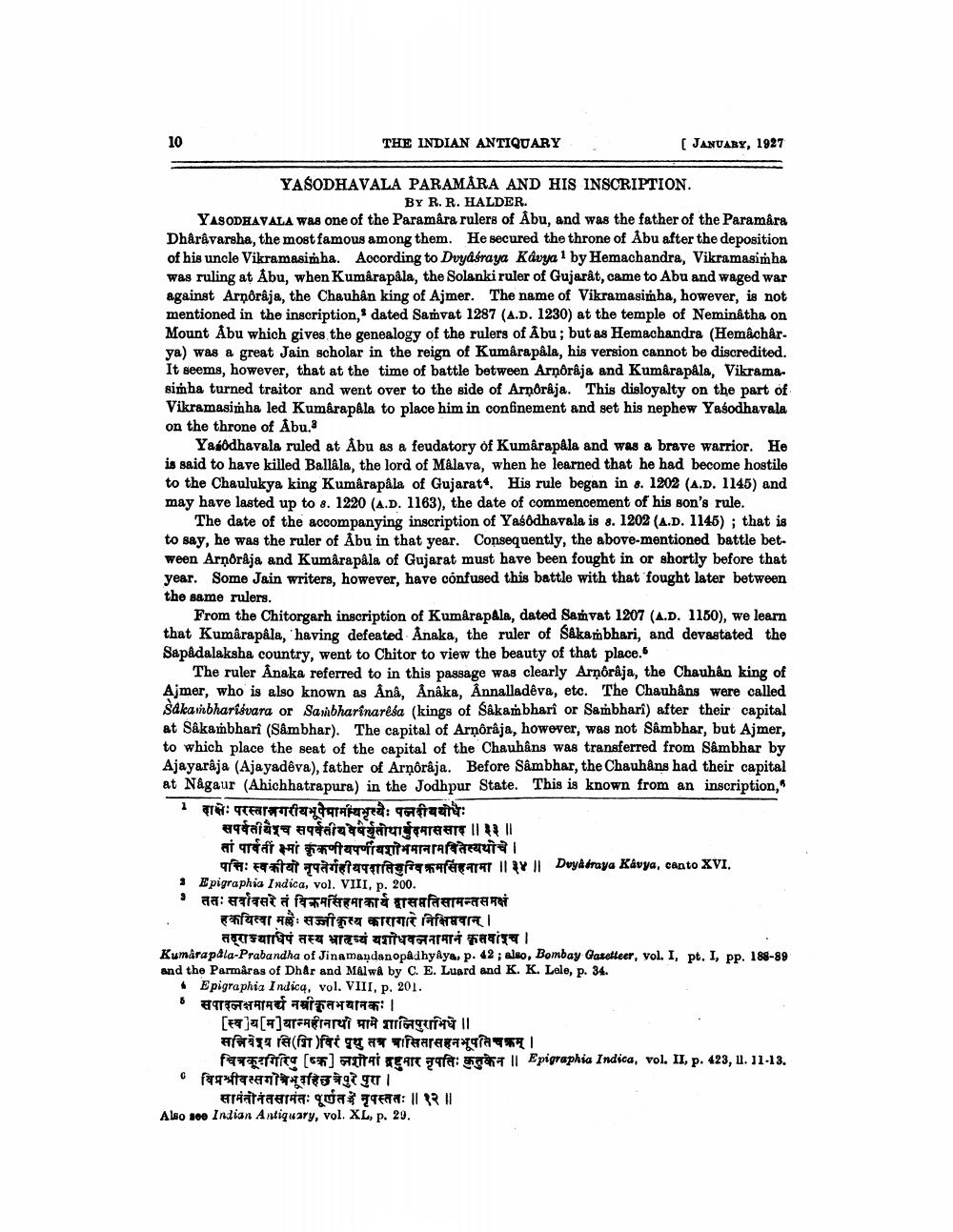________________
THE INDIAN ANTIQUARY
[ JANUARY, 1927
YASODHAVALA PARAMÅRA AND HIS INSCRIPTION.
BY R.R. HALDER. YASODHAVALA was one of the Paramâra rulers of Åbu, and was the father of the Paramara Dhårdvarsha, the most famous among them. He secured the throne of Abu after the deposition of his uncle Vikramasimha. According to Dvyasraya Kavya 1 by Hemachandra, Vikramasimha was ruling at Abu, when Kumarapala, the Solanki ruler of Gujarat, came to Abu and waged war against Arņôrâja, the Chauhan king of Ajmer. The name of Vikramasimha, however, is not mentioned in the inscription, dated Saṁvat 1287 (A.D. 1230) at the temple of Neminátha on Mount Abu which gives the genealogy of the rulers of Abu; but as Hemachandra (Hemachår. ya) was a great Jain scholar in the reign of Kumâra påla, his version cannot be discredited. It seems, however, that at the time of battle between Arnórája and Kumarapala, Vikramasimha turned traitor and went over to the side of Arņārâja. This disloyalty on the part of Vikramasimha led Kumarapala to place him in confinement and set his nephew Yasodhavala on the throne of Abu.
Yahodhavala ruled at Abu as a feudatory of Kumarapala and was a brave warrior. He is said to have killed Ballâla, the lord of Málava, when he learned that he had become hostile to the Chaulukya king Kumârapåla of Gujarat. His rule began in 8. 1202 (A.D. 1145) and may have lasted up to 8. 1220 (A.D. 1163), the date of commencement of his son's rule.
The date of the accompanying inscription of Yaśôdhavala is s. 1202 (A.D. 1145) ; that is to say, he was the ruler of Abu in that year. Consequently, the above-mentioned battle between Arņôråja and Kumarapala of Gujarat must have been fought in or shortly before that year. Some Jain writers, however, have confused this battle with that fought later between the same rulers.
From the Chitorgarh inscription of Kumarapala, dated Samvat 1207 (A.D. 1150), we learn that Kumarapala, 'having defeated Anaka, the ruler of Sakambhari, and devastated the Sapadalaksha country, went to Chitor to view the beauty of that place.
The ruler Ånaka referred to in this passage was clearly Arņôrâja, the Chauhan king of Ajmer, who is also known as Ana, Anâka, Annalladêva, etc. The Chauhåns were called sakanbharisvara or Sambharinaréša (kings of Sakambharî or Sambhari) after their capital at Såkambhari (Sâmbhar). The capital of Arņôrâja, however, was not Sâmbhar, but Ajmer, to which place the seat of the capital of the Chauhåns was transferred from Sâmbhar by Ajayaraja (Ajayadêva), father of Arnórája. Before Sambhar, the Chauhans had their capital at Någaur (Ahichhatrapura) in the Jodhpur State. This is known from an inscription, 1 दाक्षेः परस्वानगरीयभूपैमाथिभृत्यैः पनीययोधैः
सपर्वतीयश्च सपर्वतीय वैर्युतोथार्बुदमाससाद ||३३ ॥ तां पार्वती मां कृकणीयपर्णीयशोभमानामवितेस्यथोचे । T: Fata Tatatatag
11 48 || Duyasraya Kavya, canto XVI. * Epigraphia Indica, vol. VIII, p. 200. ततः सर्वावसरे तं विक्रमसिंहमाकार्य द्वासप्ततिसामन्तसमक्ष
हकयित्वा मले सज्जीकृस्य कारागारे निक्षितवान् |
ताज्याधिपं तस्य भातव्यं यशोधवजनामानं कृतवांश्च । Kumarapala-Prabandha of Jinamandanopadhyâye, p. 42; also, Bombay Gazetteer, vol. I, pt. I, pp. 188-89 and the Parmaras of Dhår and Malwa by C. E. Luard and K. K. Lele, p. 34.
. Epigraphia Indica, vol. VIII, p. 201. • सपादनक्षमामर्थ नम्रीकृतभयानका
[*]0[*]anerari FIÀ TIIG GUTII
forure (fa)fert qu Titaaragargra !
fa r i (6 ) at EART fa: 7 Epigraphia Indica, vol. II, p. 423, 11. 11-13. • fr a zit gal
सामंतीनंतसामंतः पूर्णतः नृपस्ततः ।। १२ ।। Also see Indian Antiquary, vol. XL, p. 29.




